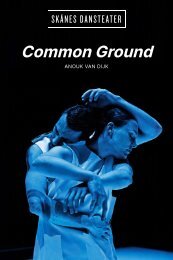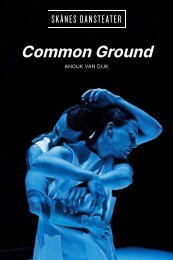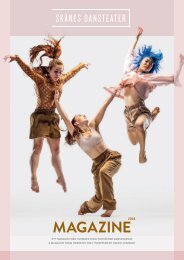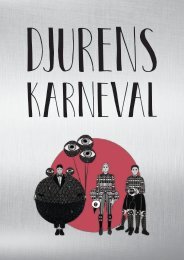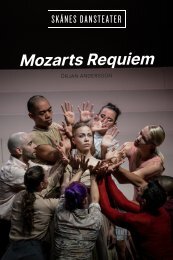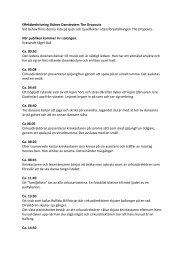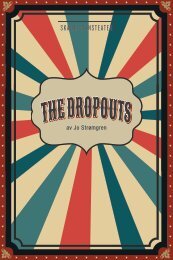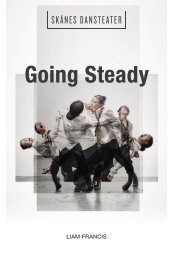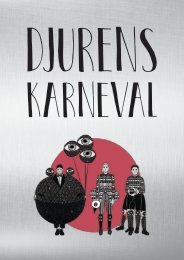Skånes Dansteater Magazine 2022
Skånes Dansteaters magasin om dansen, föreställningarna, mötena och konstnärerna som väntar på Sveriges enda fristående dansinstitution. Skånes Dansteater's Magazine 2022 about the dance, the performances, the artists, the encounters and the artists we are hosting during 2022.
Skånes Dansteaters magasin om dansen, föreställningarna, mötena och konstnärerna som väntar på Sveriges enda fristående dansinstitution.
Skånes Dansteater's Magazine 2022 about the dance, the performances, the artists, the encounters and the artists we are hosting during 2022.
Create successful ePaper yourself
Turn your PDF publications into a flip-book with our unique Google optimized e-Paper software.
MAGAZINE <strong>2022</strong><br />
TEXT: MARIA-THÉRÈSE SOMMAR<br />
PHOTOS: MARTINA LANOTTE, LUKAS HARTVIG-MØLLER & SØREN MEISNER<br />
DON’T, KISS .SKÅNES<br />
THE MAGIC OF<br />
CONNECTION<br />
Two individuals approach each<br />
other. Cautiously, slowly, purposefully.<br />
Leaning forward, they<br />
fall into each other and land –<br />
in a kiss. At first, only their lips<br />
touch, clasping onto each other.<br />
Then, a dance, a communication<br />
of bodies starts, and a relationship<br />
unfolds.<br />
Fabio Liberti’s Don’t, Kiss has travelled<br />
the world in its original form,<br />
been transformed from a duet to<br />
include more couples and diversity,<br />
performed as a group choreography<br />
for the first time by Norrdans. It has<br />
also been filmed, surprisingly – since,<br />
after all, we’re dealing with dance<br />
– showing very little of the entire<br />
choreography, but instead focusing<br />
on close-ups, on the very kiss, the<br />
negotiation of tongues and what<br />
dancers.<br />
Now, as Liberti brings the piece<br />
to Skånes <strong>Dansteater</strong> in <strong>2022</strong>, it is<br />
metamorphosing once again, into a<br />
much longer work, involving multiple<br />
pairs of dancers, still centred around<br />
a kiss that the dancers cannot, or will<br />
not, escape.<br />
The original piece was born in<br />
2017, Fabio Liberti explains:<br />
- At first, it was basically an idea I<br />
played around with in my studio with<br />
a colleague of mine at the time. Then I<br />
was invited by a company in Germany,<br />
after sending them what I had.<br />
They were interested in the piece,<br />
but found it too sexual, meaning, in<br />
fact, too homosexual. They said the<br />
audience was too conservative.<br />
Fabio had a big decision to make:<br />
Should he stage it with a female<br />
and male dancer, or keep it as it<br />
was, at the risk of being censored?<br />
- It was an important moment for<br />
me, as I see it as a performance<br />
that talks about relationships,<br />
not homosexuality. But we are<br />
where we are in this world. A lot<br />
has improved in the last decades,<br />
but there is still a lot to do. We will<br />
eventually achieve a change, and<br />
maybe real and total equality, but<br />
probably not in our generation; it<br />
will take some generations for it to<br />
happen. I accepted, and staged it as a<br />
heterosexual couple.<br />
Wasn’t this a big compromise or even<br />
a sacrifice for you?<br />
- No, as a choreographer it wasn’t a<br />
problem. The duet is not about that;<br />
it didn’t lose anything in its form. If<br />
you ask me as a homosexual person, I<br />
might feel differently and I have to do<br />
my part, but not as a choreographer.<br />
In some places, it’s a duet. In others,<br />
it’s a gay duet.<br />
The title of the piece includes a<br />
comma: Don’t, Kiss. There is a pause,<br />
10 little space remains between the two something you are not telling us. when the dancers slap each other.<br />
11<br />
Don’t … what? Instead of something,<br />
kiss! What is it you’re telling us not<br />
to do?<br />
- Leave, perhaps. Don’t leave, kiss<br />
instead. Or don’t argue, kiss. The<br />
kiss represents the full relationship<br />
to me: Are you happy? Do you want<br />
this? Is the kiss a present you might<br />
like? This has no gender. The very<br />
core is communication, and just<br />
as important – contrast. The good<br />
things can also be problematic things.<br />
Can you give an example of something<br />
good that is also problematic?<br />
- I’m a kind of person who sees things<br />
from very different perspectives.<br />
There’s no good and bad. My own<br />
relationships ended because of<br />
something that was there from the<br />
beginning. What I’m interested in is<br />
the contrast in a situation – they are<br />
stuck with each other, but they are<br />
free to walk away. A kiss is universally<br />
connotated with tenderness, which is<br />
universally a positive connotation.<br />
Sex is different. In sex, you have<br />
different roles. A kiss is equal, a<br />
mutual act.<br />
I’ve seen you describe the piece<br />
as dealing with addiction. To me,<br />
addiction sounds negative and I’d<br />
have a hard time seeing another side<br />
to it, as being neither good nor bad.<br />
Can you explain what you mean?<br />
- Yes, addiction is something I<br />
want to explore with the piece,<br />
and also dependence. If we want to<br />
bring it down to ‘What is a healthy<br />
relationship?’ it would be ideal,<br />
but almost impossible, to have a<br />
relationship without some kind of<br />
dependence. Negotiation is a word I<br />
like. We have to support one another<br />
and be there, a lot of communication<br />
is necessary and this can also get ugly.<br />
As the dancers move – not as one<br />
body, but as two bodies connected –<br />
they struggle and almost separate. In<br />
the original duet, the conflict in the<br />
relationship portrayed culminates<br />
- For me, it was important for it to<br />
be equal, to not pick sides or have<br />
a victim in these situations. In the<br />
duet, the slap hurts not only the<br />
one receiving it but, because of<br />
the lips connection, it hurts both<br />
of us. I did not choose to keep the<br />
slapping in a male/female version,<br />
as the connotations would be quite<br />
different.<br />
Fabio talks about the restrictions<br />
of the piece, as well as the sheer<br />
physical challenge of kissing<br />
another dancer throughout the<br />
performance: - The simplicity of<br />
kissing makes it very challenging. I<br />
establish a strong limitation and try<br />
to stick to it. How do we find doors<br />
in this small place that seems to have<br />
no doors? It’s challenging, but in the<br />
end it’s rewarding. I was interested<br />
in exploring what happens with<br />
such restrictions. How do you<br />
move? You constantly negotiate.<br />
You’re never independent. The<br />
balance is constantly in the middle;<br />
you’re always leaning when you<br />
kiss, which is very challenging for<br />
the neck.





